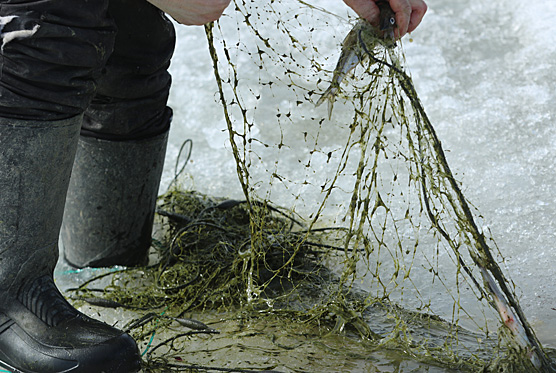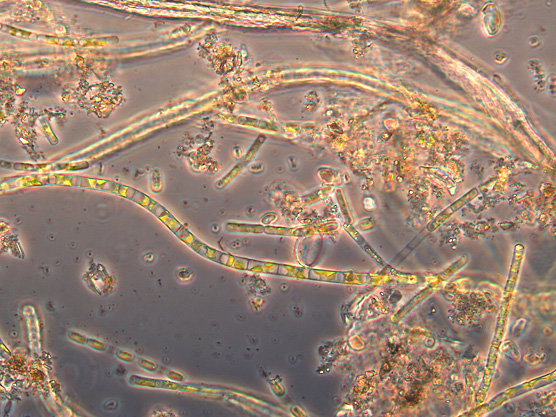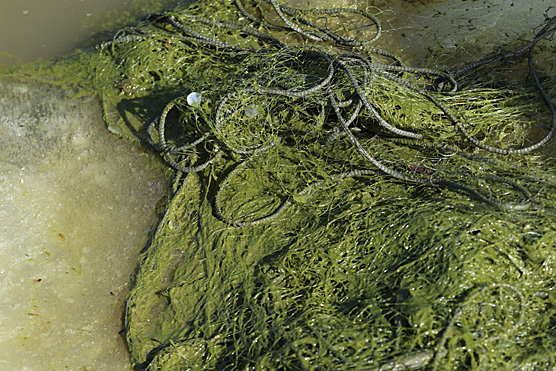
On the coast in front of Sipoo, the fouling on fishing nets has been caused mostly by filamentous green algae. © Photo Seppo Knuuttila
The Finnish Environment Institute has in March-April received reports of algae fouling fishing nets under ice on the coast of the Gulf of Finland. Fouling has been exceptionally intense this spring in the Sipoo archipelago. The fouling has been caused mainly by filamentous green algae. Fouling of fishing nets has also been observed in Helsinki and Hamina. The growth of green algae has been favoured by the long ice cover season together with the sunny weather. Green algae thrive in cool water. They are not toxic.
Gustaf Nordenswan, who fishes in Sipoo's Gumbostrand, announced an exceptionally strong fouling on his nets to SYKE in April. “I have been fishing with nets in this area since the mid-1970s. The algal fouling of nets under ice in late winter or spring has become more common in the 21st century, but this spring has been by far the worst”, says Gustaf Nordenswan.
The samples from fishing nets proved that filamentous green algae was the main cause of fouling. In the samples taken from water in front of Lauttasaari in Helsinki, typical spring-time diatoms were dominant, but researchers found some decaying filamentous green algae also in those samples.
The long ice-covered season may have favoured the growth of green algae
According to Harri Kuosa, a leading researcher at SYKE, there are no known changes in the marine ecosystem that would favour specifically green algae to cause the fouling.
“This spring, the coast of the Gulf of Finland had a strong, long-lasting ice cover. Together with the sunny weather, it may have favoured the growth of filamentous green algae that thrive especially in cold water. Later in the spring, the fouling along the coasts is usually caused by diatoms. The spring bloom of phytoplankton reaches its peak when the ice has left”, says Harri Kuosa.
According to him, more information is needed on possible changes in the composition and dominance of algal communities that cause fouling.
Algal growth begins to accelerate in the spring, already under ice cover as soon as the amount of sun light increases. The nutrients that algae need to grow are abundant in the water in the spring.
"Spring bloom of phytoplankton often receives less attention than cyanobacterial blooms in summer, as people spend less time close to water in spring compared to summer. Spring bloom also does not cause health risks similarly as cyanobacterial blooms do. During the spring bloom, the dominant species are diatoms and dinoflagellates”, says Sirpa Lehtinen, a senior research scientist at SYKE.
Eutrophication increases the algal fouling
“The more nutrients there are in the water, the more algae can utilize them for their growth. In this way, eutrophication also increases algal fouling”, says Sirpa Lehtinen.
The ecological status of the waters off the coast of the Gulf of Finland is only inadequate or satisfactory. The goal is to achieve good water status in the EU by 2027. "However, the good state of the waters in the Gulf of Finland cannot be achieved in terms of eutrophication even with extensive measures in the target schedule", says Seppo Knuuttila, a senior research scientist at SYKE. He refers to a report published by SYKE last year.
“Good status can only be achieved by implementing agricultural protection measures in their entirety, including, for example, the gypsum treatment of fields. The measures would have a positive effect on the situation in the spring season in coastal waters”, emphasizes Seppo Knuuttila.
Green algae and diatoms causing fouling are not toxic
Many filamentous green algae are particularly abundant during cool water season. Green algae are not toxic. Diatoms that are abundant in Finnish sea areas in the spring, are also non-toxic. In addition to fouling, diatoms can turn the water brownish.
Green algae Ulothrix spp. caused intense fouling on nets in the inner archipelago off Helsinki also in March 2010 and 2013. Cyanobacterium Aphanizomenon spp. were present in samples taken from fishing nets in the eastern Gulf of Finland in the outer archipelago of Virolahti in March 2012. Diatoms were fouling nets in the Bay of Bothnia in Laivaniemi in April 2012 and in the Bothnian Sea off Ämttöönlahti in Pori in March 2016.
In addition to spring, the fouling on fishing nets can be observed also in other seasons. In addition to algae, also ciliates and fishhook waterfleas are fouling fishing nets.
Further information
Senior research scientist Sirpa Lehtinen, Finnish Environment Institute,
firstname.lastname@syke.fi, tel.+358 295 251 353
Senior research scientist Seppo Knuuttila, Finnish Environment Institute,
firstname.lastname@syke.fi, tel.+358 295 251 286
Leading researcher Harri Kuosa, Finnish Environment Institute,
firstname.lastname@syke.fi, tel.+358 295 251 106

Microscopic image of green algae that were fouling fishing nets in Sipoo. There were also diatoms among them. © Photo Sirpa Lehtinen

Fishing nets were covered by filamentous green algae at Sipoo Gumbostrand.
© Photo: Seppo Knuuttila